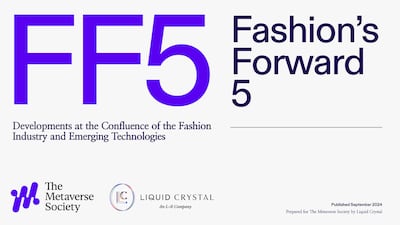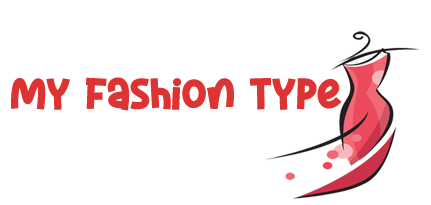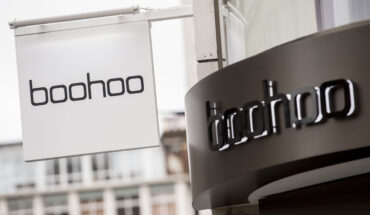According to market research firm Fact View Research, accusations that the metaverse was more hype than reality are found to be false. Their recent analysis found that the global fashion metaverse market, which was valued at $7.1 billion in 2023, is expected to reach $89.6 billion by 2032, growing at a CAGR of 33 percent over the nine-year period.
Global think tank, The Metaverse Society, understands this opportunity. Since 2023, it has aimed to bring together technologists, businesses, thinkers and academics, regulators and creators to collectively envision the metaverse as an open, decentralised, culturally and economically empowering space for all — through its current partnerships, which include Improbable, MSquared and Enders Analysis.

Below, BoF shares key extracts from The Metaverse Society’s report, highlighting the five key themes that will shape the future of the global fashion industry, redefining both business practices and customer engagement in the metaverse.
Discover further insights here.
Digital Wearables, Real-World Asset Tokenisation, Hybrid NFTs & Regulations
The Metaverse Society: Sportswear is a leading category for phygital products — physical products paired with digital twins on the blockchain — which feed into fans’ desire to build their collections. The popularity of these items shows how Web3 technologies can be used to bridge the divide between physical and virtual experiences to enhance the value of consumer spend and increase the touchpoints customers have with their favourite brands.
As of 2024, 21 of the top 50 global fashion brands have launched NFTs, with sportswear brands leading this digital shift. These NFTs offer exclusive, limited-edition products that enhance brand value and consumer engagement. The report found the following examples most successful — Dior’s B33 Sneaker and Dior Tears NFTs, Maison Margiela’s MetaTABI Digital Boots, Louis Vuitton’s NFT- Linked Varsity Jacket and Mugler’s Digital Product Passports (DPPs).
The global digital fashion professional market size was valued at approximately $101 billion in 2024 and is expected to reach $297 billion by 2032, growing at a CAGR of about 96 percent. This growth underscores the rising importance of digital assets in fashion, opening new opportunities for brands and consumers.
NFTs are changing the rules of the game, allowing brands to explore new ways to protect, personalise, and authenticate their products.
Indeed, luxury brands are leveraging Web3 technology to produce phygitals. This process of tokenisation allows customers to uphold ownership of the physical product by keeping its digital counterpart in their wallet. It’s a method of recording and guaranteeing product authenticity and traceability, but the real customer advantage is the additional brand touchpoints — enabling exclusive, personalised luxury experiences online.
The value of physical luxury goods to consumers is already an intangible one, making this sort of digital integration a natural fit — with exclusivity and design central to luxury brands’ draw, more than the narrowly defined utility of their physical product. Now, phygitals are able to open up a new revenue stream with a wider variety of products that have the potential to attract younger, tech-enthusiastic audiences and boost overall brand engagement.
In 2023, luxury Swiss watchmaker Hublot announced its fourth collection with Japanese artist Takashi Murakami, with the launch of 13 phygitals (NFTs paired with each individual physical product). The collection was that of collectibles — the first person to collect all 12 NFTs was eligible to purchase the 13th watch, the highlight of the collection.
Prada has also experimented with phygitals as a way of building exclusive brand membership. Its Timecapsule NFT collection, that debuted back in December 2019, features a limited-edition physical item paired with a gifted NFT. Phygitals were released once a month and were available for 24 hours; building a sense of community with its consumers.
Louis Vuitton continues its digital collectible offering through its VIA Treasure Trunk initiative. These trunks are “soul-bound” (non-transferrable NFTs), and their owners can purchase digital collectibles, some of which have physical counterparts. The brand plans to release 2-3 drops per year for the next 3 years. And while these collectibles can be resold on NFT platforms, the VIA Treasure Trunks are uniquely tied to the owner’s identity and cannot be resold.
BoF: The global wearables market is expected to reach $265.4 billion by 2026 — driven by a compound annual growth rate of 18 percent. Over the past several years, wearables have seen significant advances, adding fitness features, health monitoring, virtual assistants and more. There is plenty of room for improvement — and AI is poised to give wearables more functionality and improved performance.
In 2024, investments in the space have been subtle, but immersive. Arguably the most practical “quiet technology” trend in fashion is the utilisation of blockchain as an authentication tool. Chanel was an early adopter of blockchain-enabled authenticity — replacing its printed authenticity card with blockchain-enabled NFC microchips in 2021.
In 2022, LVMH, Richemont and Prada Group came together to form a non-profit alliance – the Aura Blockchain Consortium – with the explicit goal of using blockchain to battle the growing counterfeit industry. “Many products in the EU will need DPPs by 2028. Now is the time to develop these technologies, and early adopters will be best equipped to leverage DPPs as a competitive advantage,” says Romain Carrere, CEO of Aura Blockchain Consortium. In today’s data-driven, consumer-centric market, luxury brands must innovate to thrive.
Web3-Based Loyalty Initiatives
The Metaverse Society: 79 percent of consumers are more likely to continue doing business with brands that have loyalty programmes. This high percentage highlights the significant impact of loyalty programmes on customer retention and engagement.
The customer loyalty management market is valued at over $5.5 billion and is expected to exceed $24 billion by 2028. This substantial market value reflects the growing emphasis on effective loyalty programmes within the industry. The report finds Hugo Boss, Lacoste and Kiki World having successfully implemented these programmes to their consumers.
The future of Web3-based loyalty programmes is poised to revolutionise customer engagement in the fashion industry. As more brands adopt decentralised frameworks, customers will gain unprecedented control over their rewards, fostering deeper loyalty and stronger connections with their favourite brands. The transparency and security offered by blockchain technology will become a standard expectation, ensuring that loyalty programmes are not only fair but also resilient against fraud.
It’s to be expected that these programmes are to become increasingly sophisticated, integrating more personalised and community-driven features. Customers will likely have the ability to trade or transfer their rewards across different platforms or brands, creating a more dynamic and interconnected loyalty ecosystem. Additionally, as the technology matures, Web3-based loyalty programmes will align more closely with sustainability efforts, allowing brands to reward customers for environmentally friendly behaviours.
Overall, the shift towards Web3 in loyalty programmes will not only enhance customer satisfaction but also provide brands with valuable insights into consumer behaviour, enabling them to create more tailored and effective marketing strategies. Brands that embrace this shift early on will likely see significant advantages in customer retention and brand loyalty.
BoF: Loyalty incentives appear to be the biggest draw, rather than their connection to emerging tech — both count crypto funds among their investors, operate on the blockchain and offer NFT-esque digital “collectibles”. But fashion and beauty’s NFT obsession has faded, and now even carries some stigma.
Nike’s surprise 2021 acquisition of the virtual sneaker brand RTFKT is the latest addition to the list of pandemic-era crypto bets that ultimately didn’t pan out. The four-year-old company announced last month that it would wind down operations in a statement on X. RTFKT will launch a website showcasing its work, which has spanned NFTs of digital, Takashi Murakami-designed avatars to virtual versions of Nike Dunks. But by the end of January, it will halt its services — such as the elaborate online quests it has occasionally made its community members complete to access its products.
Strategic Community Engagement
The Metaverse Society: 62 percent of consumers seek interactive activities in online communities. Additionally, 60 percent value “member-exclusive content,” 57 percent want “rewards,” and 43 percent appreciate “discussion among members.” As of July 2024, 67 percent of the world’s population, or 5.45 billion people, were using the internet. The global market for community engagement platforms is expected to grow from $608 million in 2023 to $2.76 billion by 2033. This increase highlights the growing investment and focus on digital community technologies.
The report found the following best-in-class brands in the space — Prada introduced ”PradaCrypted,” a pioneering digital engagement initiative that merges fashion with the Web3 ecosystem. Louis Vuitton introduced a high-end NFT initiative featuring its iconic Treasure Trunk. These NFTs, labeled “soul-bound,” can’t be traded on secondary markets, signaling a shift in LV’s NFT strategy towards a premium, community-driven approach. Coach launched “The Road to Circularity,” a docuseries as part of its Coachtopia brand. And finally, Gucci launched “Gucci Ancora” during Milan Fashion Week, a virtual fashion experience spanning platforms like Roblox, Zepeto, and QQ.
The future of strategic community engagement will increasingly hinge on the integration of digital platforms with real-world experiences. Brands are leading this evolution, using platforms such as Discord, Roblox, and Zepeto to craft immersive, personalised interactions that resonate with their audiences. Whether through digital communities, virtual fashion shows, or NFT collectibles, these brands are redefining consumer engagement.
As digital and physical worlds converge, the focus will shift towards creating cohesive, branded environments that offer consistent and meaningful experiences across all touchpoints. Embracing technologies like AR and VR will be crucial, ensuring they are seamlessly integrated into the brand’s identity. This will allow brands to offer richer, more immersive experiences that capture their audience’s imagination.
Hybrid experiences, where consumers fluidly transition between virtual and real-world interactions, will become a key strategy for enhancing loyalty and expanding brand visibility, particularly among Gen-Z. Brands that can effectively bridge the digital and physical realms, crafting a unified narrative, will not only keep their communities engaged but also foster deeper, lasting connections with consumers, ensuring long-term success in the ever-evolving fashion landscape.
BoF: Beyond tangible loyalty, brands have been laser-focused on the concept of “community” in recent years. The search for community has taken several forms, starting with private Facebook groups, moving on to invite-only Instagram groups, chat-specific apps like Geneva and most recently, Instagram’s broadcast channels. Community commerce apps are positioning themselves as a Gen-Z-friendly version.
Immersive Experiences via Metaverse Integration
The Metaverse Society: Around 60 percent of gamers have used the metaverse for non-gaming activities, such as shopping and socialising. The report finds four best-in-class brands succeeding in the space. Chanel ventured into the metaverse by creating digital clothing for the immersive virtual reality event, Le Bal de Paris. Attendees wear body-tracking devices and VR headsets, and Chanel designed a series of digital garments for them.
MCM debuted a virtual store in collaboration with Caliverse, marking the first partnership of its kind for a luxury brand. Gucci introduced the Gucci Meta-Mansion, a pioneering virtual space crafted by Reem Bamanie, Muhammed Shawkat, and Akshaya Rupasri as part of PAACADEMY’s “Meta-Fluid Studio 3.0″.
Also, Porsche moved its industrial manufacturing training to a new level. Part of the production process at the Zuffenhausen plant was transferred into a highly realistic 3D training course, using the Apple Vision Pro device.
The evolution of brand engagement will increasingly center around the metaverse, with games like Fortnite and Roblox serving as key environments where brands can interact with consumers in innovative and meaningful ways. These virtual worlds have grown far beyond their origins, becoming spaces where brands can build immersive experiences that resonate with a broad and diverse audience.
As brands continue to explore these virtual worlds, the integration of advanced technologies like Apple Vision Pro, Meta Quest, AI, and Web3 will play a crucial role. These tools will enable brands to offer highly personalised and secure interactions, making the consumer experience more tailored and engaging. The ability to customise and secure these interactions will become a critical factor in strengthening brand-consumer relationships.
In the future, merging virtual experiences with real-world interactions will be essential for creating a cohesive and continuous consumer journey. Brands that successfully leverage these technologies and platforms will not only reach a global audience but also create more meaningful, hybrid experiences that appeal to tech-savvy consumers. The future of consumer engagement lies in the ability to craft seamless, immersive experiences that maintain relevance in an increasingly digital world.
BoF: The declining efficiency of traditional advertising is partially due to new channels emerging to take share of mind. One in particular — gaming — is now one of the world’s most widespread digital behaviours. In 2023, the number of gamers worldwide hit 3.38 billion and the industry generated $184 billion, according to gaming data platform Newzoo — bigger than the global film business, the global TV streaming business and all of North American Sports combined.
Following Vision Pro’s release, Mytheresa, J.Crew and E.l.f. Cosmetics all offered free apps in collaboration with Obsess — a creator of virtual stores which currently works with a number of other brands on dedicated apps for Vision Pro.
Advanced Personalisation Through AI
The Metaverse Society: The future of fashion is increasingly driven by AI, with advanced personalisation becoming a key factor in how brands engage with consumers. AI is transforming the shopping experience through personalised product recommendations, tailored marketing, and dynamic pricing models that adapt to individual preferences. As this technology advances, consumers will expect more customised interactions that cater to their specific needs and tastes.
In 2023, 92 percent of surveyed companies reported using AI-driven personalisation to drive growth. 71 percent of consumers expect companies to deliver personalised interactions, and 76 percent express frustration when these expectations are not met. This underscores the growing demand for tailored experiences and the need for companies to meet these consumer expectations.
The report found four brands making strides in the space — Zegna partnered with Microsoft to create Zegna X, an AI-driven personalisation system aimed at revolutionising luxury clienteling. The project introduced the Zegna X configurator, allowing for billions of style combinations, set to be accessible both in select stores and online, signaling a significant advancement in luxury retail. Zegna X presently accounts for more than 45 percent of Zegna boutiques’ revenue.
Moncler’s first AI Campaign for Moncler Genius created ”AI exaggeration” images of their lookbook from their campaign. Kering unveiled KNXT, an innovative fashion space designed to curate content and experiment with new concepts. Valentino also launched the Maison Valentino Essentials collection alongside an innovative AI-designed campaign.
AI-generated images and designs are gaining traction in creative campaigns, providing fresh, dynamic content that resonates deeply with audiences. This technology not only streamlines the creative process but also enables more personalised and effective marketing strategies. The integration of AI into these campaigns allows brands to connect with consumers in more meaningful ways, enhancing overall engagement.
In summary, AI is poised to revolutionise every aspect of fashion, driving the next wave of personalisation and consumer engagement. As AI continues to evolve, its integration into retail and fashion design will push boundaries and set new standards, ensuring that brands remain competitive and relevant in an increasingly digital world.
BoF: The State of Fashion 2025 report found that 50 percent of fashion executives see product discovery as the key use case for generative AI in 2025, with 82 percent of customers wanting AI to assist in reducing the time they spend researching what to buy.
Indeed, reinventing product discovery will be a key focus area for fashion players in 2025 and this new era will provide customers with increased curation across search and content.
Discover further insights here.
This is a sponsored feature paid for by The Metaverse Society as part of a BoF partnership.





